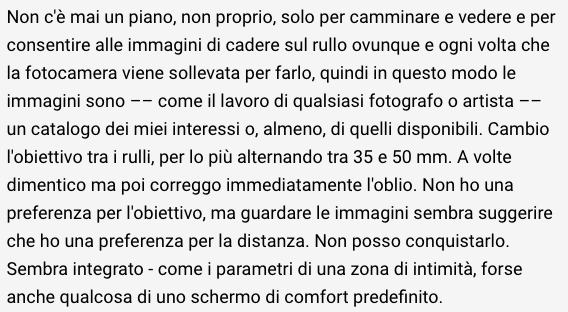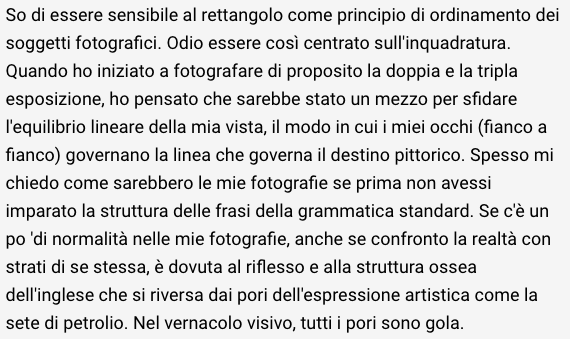There is never a plan, not really, just to walk and see and to allow the images to fall onto the roll wherever and whenever the camera is raised to do so, so in this way the images are––like the work of any photographer or artist––a catalog of my interests or, at least, the available ones. I do change the lens between rolls, mostly alternating between 35 and 50mm. Sometimes I forget but then I correct the forgetting immediately. I don’t have a lens preference but looking at the images seems to suggest that I have a distance preference. I can’t conquer it. It feels built in––like the parameters of an intimacy zone, maybe even something of a default screen of comfort.
I know that I am sensitive to the rectangle as a principle of ordering photographic subject matter. I hate being so frame-centered. When I began purposely shooting double and triple exposure, I thought it would be a means of defying the liner balance of my own sight, the way my eyes (side-by-side) govern the line that govern pictorial fate. I often wonder what my photographs would be like had I not, first, learned the sentence structure of standard grammar. If there is any normalcy in my photographs, even as I counter the reality with layers of itself, it is due to the reflex and bone structure of English which spills from the pores of artistic expression like the slick thirst for oil. In the visual vernacular, all pores are throats.
It is easy to approach (and combine) the unreal-made-surreal-made-real when the subject matter is Race. One can walk the streets all day and discover the ugly injustices and mix and match them in patterns, unknown pattern, of the imagination and marvel at the possibilities of color and contrasting black and whites till one has commented on every aspect spilled into the air, the air of advertising, the air of social unrest and the air of architecture. So many airs that the clouds (in the air) in the photograph prefer to be known as smoke and the symbols in the photographs reveal themselves as having once been people. There, too, is a sci-fi quality, an organic sci-fi quality, to some of the images that begs the question, will we become books or the intellectual property of freedom or fear.
Others will see (in these photographs) the other side of a propaganda that I will never see. For me they remain the raw stuff of solution, the things that attempt to replace +, -, = and the division symbol in the equation of the battle between Big Media and Regular Pictures. I like pictures that flow upward into the bottom in all directions I’ve tried not to shy away from the pain that exists in the dimensions between struggle, any kind of struggle. Mask or no mask, I’ve put the camera in a few of its faces and wiped the spittle of profanity from my lens before the next shot. History now comes in stickers that you can place on public walls. Even slogans have been downsized. Yes, that’s an ear beneath Harriet Tubman covering the T. Eyepatch. A flag over an eye. Flags never die. Sometimes onstage, a trumpet player will empty the saliva from his horn the same way the mouth of Trump drains. (TSE)




